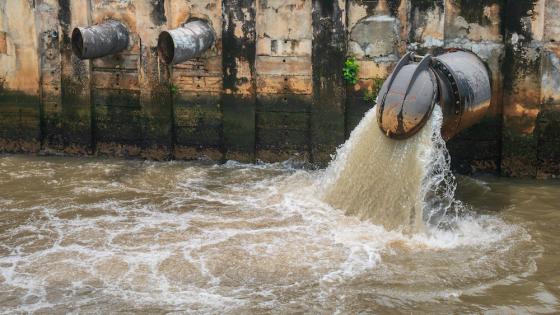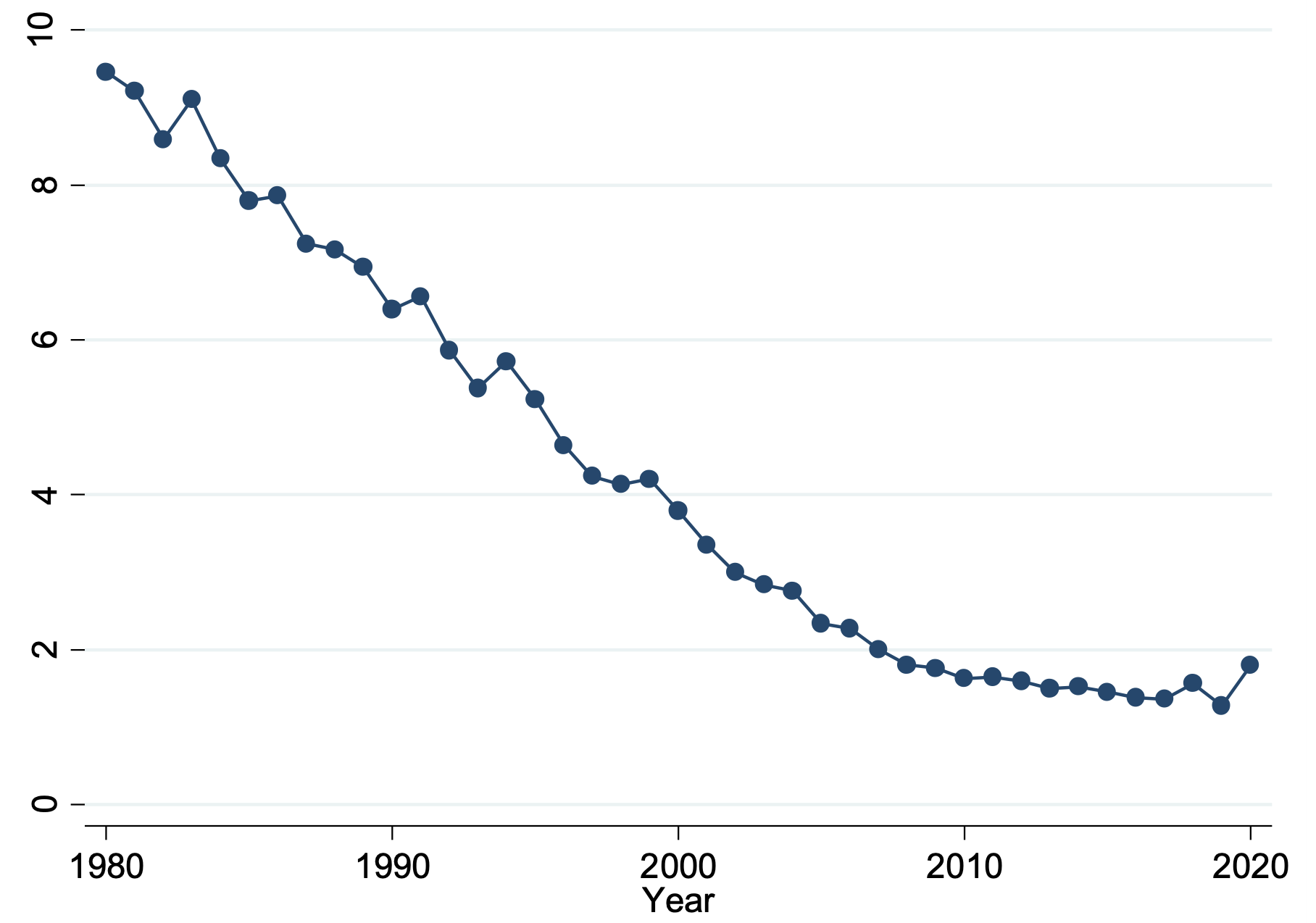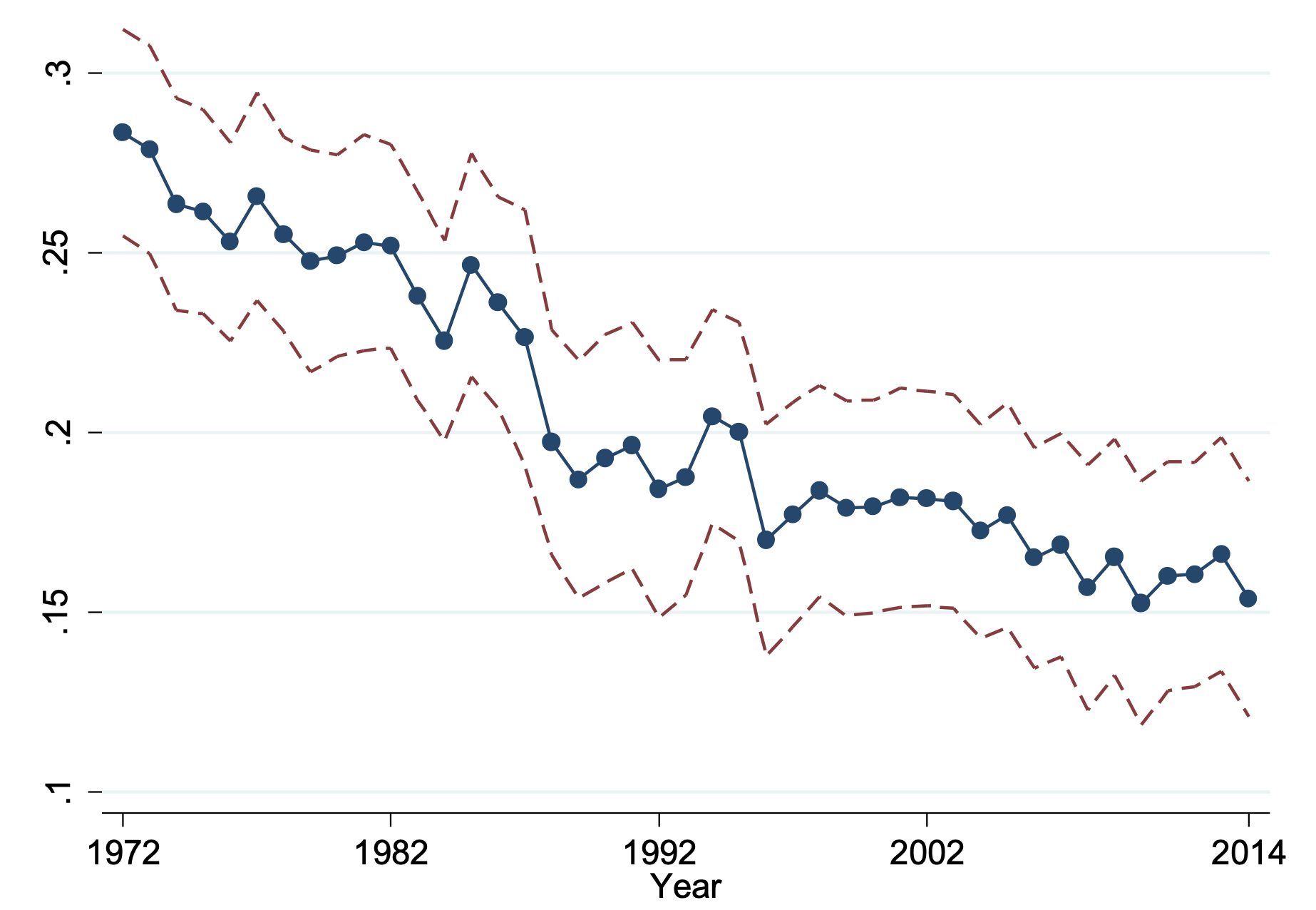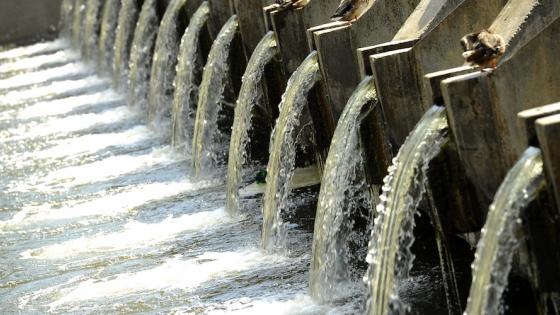In the 1960s and 1970s, concern for US environmental quality grew rapidly. This growth had many causes, including an oil spill off the coast of Santa Barbara, photos of Earth taken from space, and a fire on the Cuyahoga River in Cleveland. Spurred on by these concerns, the federal government passed a slate of environmental legislation in the early 1970s, including the Clean Air Act, Clean Water Act, Safe Drinking Water Act, and many others. These laws had enormous bipartisan support.
A half century has passed since enactment of these laws, making it a good time to assess what has been learned from 50 years of environmental policy and economic research. Several studies have summarised what research and policymakers have learned about specific individual laws or pollutants (Olmstead 2010, Currie and Walker 2019, Schmalensee and Stavins 2019, Keiser and Shapiro 2019b).
In a recent review, I seek to provide a broad overview of pollution trends, policy impacts, and distributional consequences, which might be overlooked in a single research paper or when examining a single policy, pollutant, or method in isolation (Shapiro 2021). In the review, I assess the evidence for four hypotheses:
- Hypothesis 1: Air pollution, drinking water pollution, and surface water pollution have declined substantially over the last several decades, although CO2 emissions have not.
- Hypothesis 2: Environmental policy explains a large share of long-term decreases in air and water pollution.
- Hypothesis 3: Air and drinking water policies have tended to produce benefits that exceed their costs; the evidence for surface water is much less clear.
- Hypothesis 4: While the distribution of pollution across social groups is unequal, market-based policies and command-and-control policies do not have systematically different effects on the distributions of environmental outcomes.
I also highlight recent innovations in methods and data that have improved researchers’ ability to test these hypotheses. These advances include the use of administrative data on environmental goods; use of statistical cost-benefit tests; a focus on important but understudied policies; more sophisticated models of how pollution emissions in one location affect ambient pollution concentration in other locations (i.e. pollution transport); micro-macro frameworks that combine detailed data on individual firms and households with macroeconomic models of the entire economy; and a focus on how policy affects the distribution of environmental outcomes, particularly for low-income communities and communities of colour. I discuss each hypothesis in turn.
Hypothesis 1: US air, drinking water, and surface water pollution are declining, though CO2 emissions are not
Data collected over the last half century reveal large and sustained declines in both pollution emissions and ambient concentrations. Evidence is clearest for the pollutants that the Clean Air Act, Clean Water Act, and Safe Drinking Water Act primarily target, though some evidence suggests steep downward trends in other pollutants as well. Figure 1 demonstrates this evidence by showing national trends in ambient concentrations of carbon monoxide, a harmful gas, over the period 1980-2020.
Figure 1 Ambient concentrations of carbon monoxide in the US, 1980–2020
Source: USEPA https://www.epa.gov/air-trends/carbon-monoxide-trends (visited 14 September 2021)
Figure 2 demonstrates this pattern by using data on the share of US waters that are safe for fishing, according to biological and chemical pollution standards for fishing that are widely used in water quality research.
Figure 2 Share of US waters that are not safe for fishing
Source: Figure is reprinted from Keiser and Shapiro (2019b).
Hypothesis 2: Environmental policy explains a large share of long-term decreases in air and water pollution
One could imagine many possible explanations for these decreases in pollution, including environmental policy, outsourcing of dirty production abroad, innovation and productivity growth, shifts in the economy from manufacturing to services, or consumer preferences moving towards cleaner goods. Several studies directly assess the importance of various explanations and find a central role for environmental policy in explaining these trends. Shapiro and Walker (2018), for example, find that between 1990 and 2008, real output from US manufacturing grew by a third but air pollution emitted from US manufacturing fell by half or more. Microdata on firm production and a macroeconomic model of trade and pollution suggest that increasingly stringent regulation, rather than trade policy or productivity growth, best explains this decrease in pollution.
Another analysis focuses on air pollution from passenger vehicles and finds that the air pollution emitted per mile driven has fallen by more than 99% since regulation began in the late 1960s (Jacobsen et al. 2021). One could imagine a range of reasons for this environmental improvement, including productivity growth in vehicle manufacturing, fuel economy or fuel content standards, or changing composition of vehicles due to consumer preferences. This analysis finds that the Clean Air Act’s exhaust standards for mobile sources, which limit the pollution emitted per mile driven for new vehicles, explain between half and all of this decrease in emission rates from passenger transportation.
Hypothesis 3: Air and drinking water policies have tended to produce benefits that exceed their costs; the evidence for surface water is much less clear
Since the Reagan administration, the federal government has required benefit–cost analyses of large federal regulations. A review of dozens of these analyses conducted in the last 20 years finds that they estimate overall benefit–cost ratios of 12.4 for air pollution regulations, 4.8 for drinking water pollution regulations, 3.0 for greenhouse gases, and 0.8 for surface water pollution (Keiser and Shapiro 2019b). An earlier review of such analyses conducted before the year 2000 also found high benefit–cost ratios for air and drinking water pollution policy but a lower measured benefit–cost ratio for surface water pollution policy (Hahn 2000).
Of course, one can question the accuracy of these analyses. Estimated air pollution benefits depend heavily on estimates of how ambient particular matter concentrations affect adult mortality and on estimates of the value of a statistical life – both of which have a range of estimates. Estimates of benefits from surface water pollution generally assume these benefits accrue primarily due to improved recreational opportunities, and typically assume the high stringency of drinking water regulation means there are few or no of improving surface water quality due to health. In addition, estimates of costs in these regulatory analyses typically rely on engineering estimates of physical control costs, which abstract from important economic forces like changes in market power, product quality, and interactions with pre-existing taxes and distortionary policies in markets for other goods and services. At the same time, richer analyses of individual policies also tend to find large benefit–cost ratios for air pollution policy (e.g. Shapiro and Walker 2020) and much smaller benefit–cost ratios for surface water quality policy (e.g. Keiser and Shapiro 2019a).
Hypothesis 4: While the distribution of pollution across social groups is unequal, market-based policies and command-and-control policies do not have systematically different effects on the distributions of environmental outcomes
Market-based environmental policies include pollution taxes, cap-and-trade markets, and combinations of these. Economists tend to advocate market-based policies because they maximise pollution reduction for a given cost, i.e. they are cost effective. Environmental justice describes the fair treatment and meaningful involvement of all people in design, implementation, and enforcement of environmental policies, and achievement of good environmental quality for all social groups. Environmental justice is one of the Biden administration’s top two environmental policy concerns, alongside climate change.
Some community and political groups have argued that environmental markets exacerbate environmental justice concerns. Both Washington State’s carbon tax proposal (Initiative 732) and California’s cap-and-trade renewal (AB 398) faced opposition from some progressive groups due to environmental justice concerns (Brown 2020). Additionally, the Biden administration reportedly considered former California Air Resources Board head Mary Nichols to serve as Administrator of the Environmental Protection Agency but stopped that consideration after environmental justice groups raised concerns about her role in creating California’s cap-and-trade bill (Davenport 2020).
Several studies have investigated how market-based environmental policies affect the distribution of environmental outcomes. Some research compares one cap-and-trade market for nitrogen oxides in the Los Angeles region against the alternative of a command-and-control policy (Fowlie et al. 2012). The authors also analyse pollution emitted from industrial sources and find that the market had similar decreases for different demographic groups. An analysis of ambient air quality finds that the market disproportionately benefitted high-income and white communities (Grainger and Ruangmas 2018). Another analysis investigates how California’s cap-and-trade market for CO2 affected air pollution and finds that the market decreased air pollution inequality between advantaged and disadvantaged zip codes (Hernandez-Cortes and Meng 2021). Finally, another recent analysis examines the Clean Air Act’s requirement that large new dirty factories in polluted counties must purchase the right to emit pollution from incumbents (Shapiro and Walker 2021). This requirement does not appear to disproportionately relocate pollution from or to low-income communities or communities of colour.
Conclusions
These hypotheses tell a fairly coherent story, with largely good news for policy and society. Air and water pollution are declining but greenhouse gas emissions are not because environmental policy has targeted air and water pollution but not CO2. These trends appear to provide large net benefits to US society and using cost-effective market-based policies does not appear to have systematic implications for the equality of environmental outcomes.
References
Currie, J and R Walker (2019), “What Do Economists Have to Say about the Clean Air Act 50 Years after the Establishment of the Environmental Protection Agency?”, Journal of Economic Perspectives 33(4): 3-26.
Davenport, C (2020), “Claims of ‘Bleak’ Environmental Justice Record Appear to Fell a Biden Favorite”, New York Times, 18 December.
Fowlie, M, S P Holland, and E T Mansur (2012), “What Do Emissions Markets Deliver and to Whom? Evidence from Southern California’s NOx Trading Program”, American Economic Review 102(2): 965-93.
Grainger, C and T Ruangmas (2018), “Who Wins from Emissions Trading? Evidence from California”, Environmental and Resource Economics 71: 702-727.
Hahn, R W (2000), Reviving Regulatory Reform: A Global Perspective, American Enterprise Institute–Brookings Joint Center for Regulatory Studies.
Hernandez-Cortes, D and K Meng (2020), “Do Environmental Markets Cause Environmental Injustice? Evidence from California’s Carbon Market”, NBER Working Paper 27205.
Jacobsen, M R, J M Sallee, J S Shapiro, and A A van Benthem (2021), “Regulating Untaxable Externalities: Are Vehicle Air Pollution Standards Effective and Efficient?”, mimeo, UCSD.
Keiser, D A and J S Shapiro (2019a), “Consequences of the Clean Water Act and the Demand for Water Quality”, Quarterly Journal of Economics 134(1): 349-396.
Keiser, D A and J S Shapiro (2019b), “US Water Pollution Regulation over the Last Half Century: Burning Waters to Crystal Springs?”, Journal of Economic Perspectives 33(4): 51-75.
Olmstead, S M (2010), “The Economics of Water Quality”, Review of Environmental Economics and Policy 4(1): 44-62.
Schmalensee, R, and R N Stavins (2019), “Policy Evolution under the Clean Air Act”, Journal of Economic Perspectives 33(4): 27-50.
Shapiro, J S (2021), “Pollution Trends and US Environmental Policy: Lessons from the Last Half Century”, NBER Working Paper 29478.
Shapiro, J S and R Walker (2018), “Why is Moving? Environmental Markets and Environmental Justice”, AEA Papers and Proceedings 111: 410-14.





